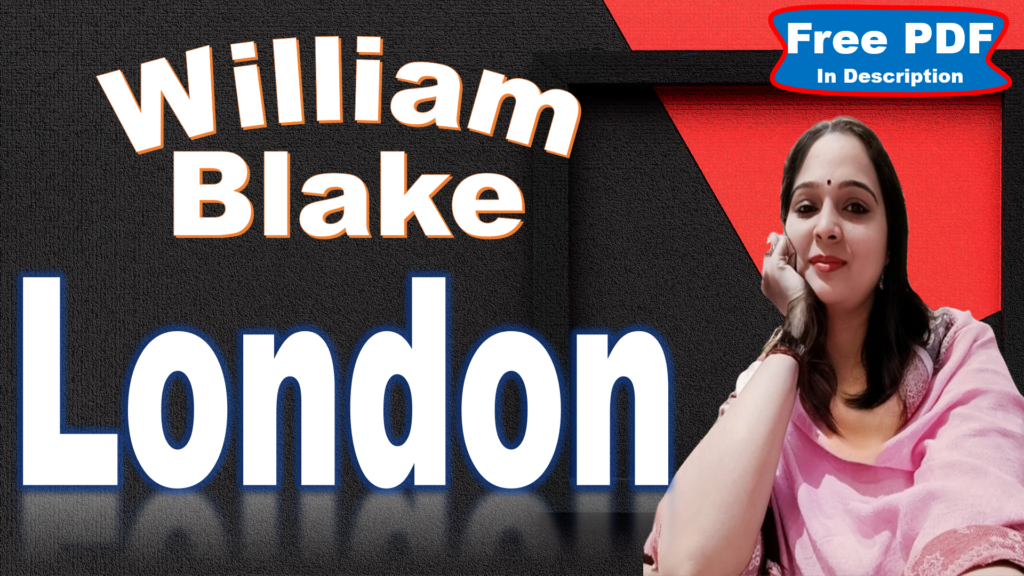
Essay Type Questions
Write the critical appreciation of the poem “London” by William Blake.
1. Introduction
William Blake’s poem “London” serves as a poignant critique of the social, political, and economic conditions prevailing in the city during the late 18th century. Through vivid imagery and poignant language, Blake exposes the suffering, corruption, and moral decay that permeate London society. The poem serves as both a protest against societal ills and a timeless commentary on human struggles.
2. Structure
“London” consists of four regular stanzas, each containing four lines (quatrains). The poem follows a consistent pattern, maintaining its structure throughout. The poem exhibits an alternate rhyme scheme (ABAB) in each stanza. This choice adds a sense of order to the chaotic subject matter.
3. Plot
The speaker takes a walk through the streets of London, observing the faces and hearing the cries of its inhabitants. The poem captures the misery, oppression, and moral degradation prevalent in the city. The speaker encounters chimney sweepers, soldiers, and harlots, all victims of a corrupt system. The poem culminates in a haunting image of a marriage hearse, symbolizing the decay of love and societal norms.
4. Style
Imagery: Blake skillfully employs vivid images to convey the bleakness of London life. The chartered streets, Thames, cries of chimney sweepers, blackening churches, and blood on palace walls evoke a sense of despair.
Symbolism: The mind-forged manacles represent mental constraints imposed by societal norms. The harlot’s curse and the new-born infant’s tear symbolize the consequences of loveless marriages and adultery.
Satire: Blake’s biting satire targets the corrupt values and ethics of London society. He denounces the degradation of humanity and the oppressive systems in place.
5. Themes
William Blake’s poem “London” delves into the harsh realities of urban life during the late 18th century. Through vivid imagery and poignant language, Blake critiques societal norms, moral decay, and the suffering faced by Londoners. Let’s explore the major themes present in this evocative poem:
Oppression of Urban Life
The poem vividly portrays the oppressive atmosphere of London. The term “charter’d” suggests control and restriction, emphasizing the city’s constrained spaces.
The cries of chimney-sweepers, soldiers, and harlots reveal the suffering endured by different segments of society.
Blake highlights the mental imprisonment (“mind-forg’d manacles”) imposed by societal norms.
The Corruption of Childhood
Innocence is lost in the grim cityscape. The cries of infants and the exploitation of children (chimney-sweepers) underscore this theme.
The blackening churches symbolize moral corruption, contrasting with the purity associated with religious institutions.
Sexual Perversion and Decay
The youthful harlots’ curses and the new-born infants’ tears represent sexual degradation and societal decay.
The paradoxical image of the “marriage hearse” suggests that even sacred institutions are tainted.
6. Poetic Devices
William Blake masterfully employs various poetic devices in his poem “London.” These literary techniques enhance the impact of the poem and contribute to its overall meaning. Let’s explore these devices in detail:
Enjambment
Definition: Enjambment occurs when a line of poetry runs over into the next line without a pause or punctuation.
Usage in “London”: Blake uses enjambment to create a flowing rhythm, connecting ideas across lines. For example:
And mark in every face I meet
Marks of weakness, marks of woe.
Metaphor
Definition: A metaphor is a figure of speech that compares two unlike things without using “like” or “as.”
Usage in “London”: The phrase “mind-forg’d manacles” is a metaphor. It symbolizes mental constraints imposed by societal norms, emphasizing the psychological imprisonment experienced by individuals.
Symbolism
Definition: Symbolism involves using objects, actions, or words to represent abstract ideas or concepts.
Usage in “London”:
Chimney-sweepers: Symbolize child labor and exploitation.
Blackening Church: Represents moral corruption within religious institutions.
Marriage Hearse: Symbolizes the decay of love and societal norms.
Alliteration
Definition: Alliteration is the repetition of consonant sounds at the beginning of adjacent words.
Usage in “London”: Examples include:
“Marks of weakness, marks of woe.”
Imagery
Definition: Imagery involves creating vivid mental pictures through descriptive language.
Usage in “London”: Blake’s descriptions of faces, cries, blood on palace walls, and harlots’ curses evoke powerful visual images, enhancing the poem’s impact.
Irony
Definition: Irony occurs when there is a contrast between expectation and reality.
Usage in “London”: The juxtaposition of the “blackening Church” and the suffering soldiers creates irony, revealing the corruption within seemingly sacred institutions.
7. Message
“London” serves as a timeless warning against societal decay, emphasizing the need for compassion, love, and social change.
8. Conclusion
Blake’s “London” remains relevant today, urging us to examine our own societies and strive for a more compassionate and just world.





